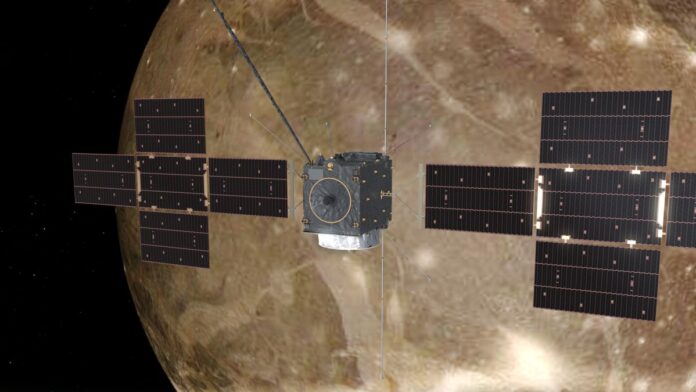Europe’s flagship Jupiter mission is struggling to unfurl an antenna in deep space.
The Jupiter Icy Moons Explorer or JUICE spacecraft has a stuck antenna on one of its instruments, European Space Agency (ESA) officials reported Friday (April 28). The instrument is designed to penetrate the icy surface of Jupiter moons using radar, to seek signs of habitable conditions for life in the waters beneath.
“A matter of millimeters could make the difference to set the rest of the radar free,” ESA officials wrote in an update (opens in new tab). Teams working on the partially deployed antenna “have lots of ideas up their sleeves” to free up the jam, they added.
Related: Europe successfully launches JUICE to study Jupiter’s icy moons
(opens in new tab)
The $1.1 billion (870 million euros) JUICE launched on April 14 for an expected arrival at Jupiter’s system in July 2031, where it will spend years flying around the icy Jupiter moons and learning more about their potentially life-friendly environments.
While 10 of the 11 spacecraft instruments are working fine so far, the spacecraft’s Radar for Icy Moons Exploration (RIME) antenna is jammed in its mounting bracket. Engineers suspect a tiny stuck pin is holding it in place.
“Various options are still available to nudge the important instrument out of its current position,” ESA officials wrote. “The next steps to fully deploy the antenna include an engine burn to shake the spacecraft a little, followed by a series of rotations that will turn JUICE, warming up the mount and radar, which are currently in the cold shadows.”
Commissioning, or the first steps of getting a spacecraft ready for its mission, is ongoing for about the next two months. ESA officials emphasized there is “plenty of time for teams to get to the bottom of the RIME deployment issue” in the time remaining.
Assuming the 52-foot (16-meter) antenna unjams, it will allow JUICE to see as far as 20 feet (9 meters) underneath Jupiter moons like Ganymede or Europa. Europa in particular has shown signs of spewing water into space, suggesting the ice has exposure to the outside environment.
This is not the first time a Jovian mission faced antenna issues. NASA’s Galileo mission never was able to deploy its high-gain antenna properly ahead of visiting Jupiter and its icy moons between 1995 and 2003. The mission still sent data back home, but at a lower rate than designed for.
Elizabeth Howell is the co-author of “Why Am I Taller (opens in new tab)?” (ECW Press, 2022; with Canadian astronaut Dave Williams), a book about space medicine. Follow her on Twitter @howellspace (opens in new tab). Follow us on Twitter @Spacedotcom (opens in new tab) or Facebook (opens in new tab).

